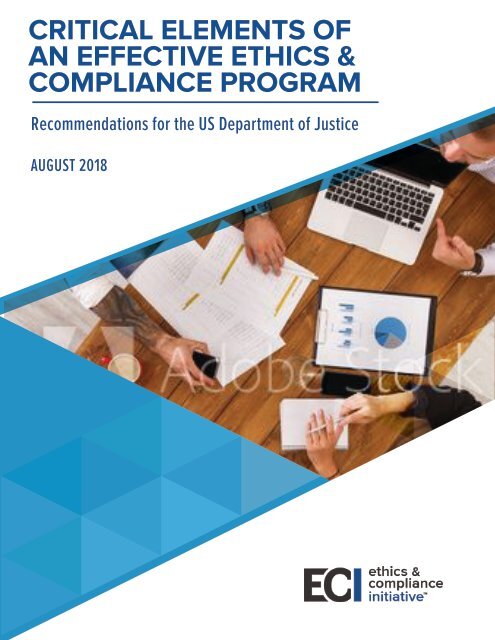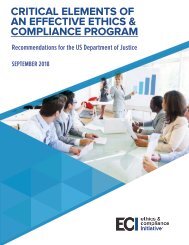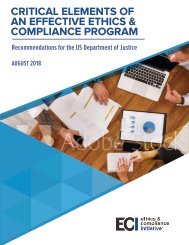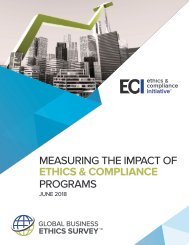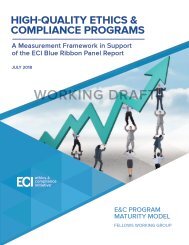ECI White Paper - FINAL DRAFT
Create successful ePaper yourself
Turn your PDF publications into a flip-book with our unique Google optimized e-Paper software.
CRITICAL ELEMENTS OF<br />
AN EFFECTIVE ETHICS &<br />
COMPLIANCE PROGRAM<br />
Recommendations for the US Department of Justice<br />
AUGUST 2018
EXECUTIVE SUMMARY
MEASURING THE IMPACT OF E&C PROGRAMS<br />
TABLE OF CONTENTS<br />
© 2018 Ethics & Compliance Initiative | 3
1<br />
<strong>ECI</strong>’s Assessment Tool can be found here. PROGRAM QUALITY ASSESSMENT TOOL, ETHICS &<br />
COMPLIANCE INITIATIVE, http://www.ethics.org/resources/self-assessment-tool.
<strong>ECI</strong>’S GLOBAL BUSINESS<br />
ETHICS SURVEY (GBES)
10<br />
Fear of retaliation remains a consistent barrier to reporting. In 2013, 56 percent of those who chose not to<br />
report misconduct cited fear or knowledge of retaliation as the reason for their silence. See pp. 27 of Ethics Resource<br />
Center (2013). National business ethics survey 2013®. Arlington, VA: Ethics Resource Center.
MEASURING AN<br />
ORGANIZATION’S<br />
IMPLEMENTATION OF<br />
THE SIX CRITICAL<br />
ELEMENTS
Measuring an Organization’s Implementation of the Six Critical Elements<br />
Several tools exist for measuring the progress of a particular company in implementing the six elements that<br />
are critical to an effective E&C program. One such tool is the <strong>ECI</strong> Measurement Framework, and to that end,<br />
the following section highlights some of the metrics and other suggestions that are provided in that report.<br />
The list is meant to be illustrative, and not exhaustive. For more metrics, please see the Measurement<br />
Framework.<br />
Measuring Tone at the Top and Tone in the Middle<br />
What to Measure/Review:<br />
• Resources (staff and funding) allocated to E&C program (dedicated and non-dedicated);<br />
• Governance documents around E&C program (e.g., Code of Conduct and related policies,<br />
Board access, E&C Committee charter, escalation procedures, etc.);<br />
• Level of E&C integration into the organization’s business operations;<br />
• Level of E&C program review and continuous improvement cycle.<br />
• The extent to which leaders personally demonstrate a commitment to ethics and<br />
compliance;<br />
• The extent to which leaders are engaged to promote and enforce a culture of ethics and<br />
compliance;<br />
• Employee feedback regarding trust in leadership and fear of retaliation for reporting;<br />
• Leadership performance reviews include an evaluation component for relevant areas;<br />
• Support and resources provided to leaders to connect values with daily business<br />
operations.<br />
Questions to Consider:<br />
• Does E&C have a formal charter?<br />
• Does E&C have a seat at the table? (i.e. substantially integrated into business decision<br />
making?)<br />
• Is E&C involved in strategic and crisis management decisions for the organization?<br />
25
• Does the Board meet regularly with the E&C officer, including in private session?<br />
• Is the E&C program continuously improved through leadership and feedback loops?<br />
• Is there an ethics committee or is ethics and compliance a standing agenda on leadership<br />
meetings?<br />
• Who sets the tone and is responsible for company’s ethical culture?<br />
• Does senior leadership link good ethics with good business when making internal and<br />
external presentations about the company?<br />
• Do employees fear retaliation for speaking up when they observe misconduct?<br />
• Is there consistent organizational justice (i.e., similar discipline regardless of subject’s<br />
position)?<br />
• Are leaders at all levels of the organization evaluated on promoting an ethical work culture?<br />
Potential Sources of Information:<br />
• Organizational chart;<br />
• E&C charter or remit;<br />
• Governance documents around E&C program (e.g. committee charters);<br />
• Escalation procedures;<br />
• Ethics and compliance training materials;<br />
• Formalized ethics and compliance plans to address gaps or continuously improve the E&C<br />
program.<br />
• Ethics and compliance policies and procedures;<br />
• Leadership participation in ethics training program/Code of Conduct training;<br />
• Employee survey - employees’ perspective on leaders’ ethical conduct and concerns about<br />
reporting misconduct;<br />
• Leadership communications and materials to workforce;<br />
• Performance evaluation criteria for leaders;<br />
26
• Materials relating to E&C program support for leaders;<br />
• Communications, activities, etc. reflecting leadership support of a culture of integrity.<br />
Leading Practices:<br />
• Strategic goals for the organization include goals related to E&C;<br />
• Senior leaders articulate the ways E&C relates to their operational areas;<br />
• E&C is represented in strategic teams including the executive or management committee,<br />
enterprise risk committee, disclosure committee, etc.;<br />
• E&C leaders are visible and prominent, sending a strong message that compliance and<br />
ethical conduct are high priorities for the organization;<br />
• E&C leaders participate in high-level strategic discussions and are frequently asked to offer<br />
input to ensure decision-making aligned with values;<br />
• Leaders make time for “town hall” give-and-take sessions during which E&C issues are<br />
addressed;<br />
• Senior leaders probe for new insights and improvements by asking hard questions of E&C<br />
leaders, risk owners, and others accountable for E&C performance;<br />
• The organization seeks feedback from employees on leaders’ behavior as well as E&C<br />
program tools and resources;<br />
• Board leaders and members seek and are provided comprehensive information about the<br />
organization’s E&C program;<br />
• The Board maintains a relationship with E&C through regular contact with the E&C leader<br />
and his/her team.<br />
• Leaders at all levels, including managers and supervisors, model integrity by talking about<br />
the importance of ethical conduct and referencing organizational values as a framework for<br />
their decisions, exemplifying the conduct they expect of their employees, and holding<br />
subordinates accountable for ethical behavior;<br />
• Leaders’ behaviors are a significant consideration in employment and promotion decisions;<br />
• No “waivers” of integrity standards are given to more senior personnel;<br />
• E&C performance affects compensation, advancement, and retention of all employees;<br />
27
• In everyday activities, leaders act and speak in alignment with the organization’s values;<br />
• Leaders are knowledgeable about and assume responsibility for their role as ethical<br />
leaders in the organization’<br />
• Employee feedback is sought regarding leaders’ efforts to build and sustain a strong<br />
ethical culture;<br />
• Senior managers directly communicate values and standards to employees at all company<br />
business gatherings;<br />
• For all employees, expectations are set and performance is judged on employees’ actions<br />
in alignment with organizational values, not merely technical rule compliance.<br />
Measuring a Speak-Up Workplace<br />
What to Measure/Review:<br />
• Organizational commitment to reporting and resolution of employee concerns/suspected<br />
wrongdoing;<br />
• Employee perception that their concerns are solicited and heard;<br />
• Employee awareness of available avenues to report concerns;<br />
• Employee use of reporting channels;<br />
• Leadership response to reported misconduct;<br />
• Use of case information/periodic assessments to measure effectiveness of reporting and<br />
resolution.<br />
• Investigations of misconduct are timely, neutral, thorough, competent, and consistent;<br />
• Employees who commit misconduct are treated/disciplined consistently across the<br />
organization;<br />
• The organization shares aggregate outcomes of misconduct cases with employees in some<br />
way.<br />
28
Questions to Consider:<br />
• Does ethics and compliance training and communications effectively support a “Speak-Up”<br />
culture?<br />
• Does leadership promote a “Speak-Up” culture?<br />
• Does the organization provide a broad and varied number of reporting avenues?<br />
• Is the organization’s policy clear about its standard for tracking and resolution and sharing<br />
of employee concerns after cases are closed?<br />
• Is feedback provided to employees making non-anonymous reporting of misconduct?<br />
• Is there consistency in the investigation and discipline process?<br />
• Are consequences consistent regardless of the level of violator?<br />
• Does any group within the organization have visibility into all investigation outcomes in<br />
order to ensure dots are covered?<br />
Potential Sources of Information:<br />
• Organization policies on reporting, tracking, and resolution of employee concerns;<br />
• Ethics and compliance training and communication materials specifically related to<br />
“Speaking Up” requirements;<br />
• Results of regular Speak-Up Program Assessments and/or employee surveys;<br />
• Communications and activities supporting and promoting a Speak-Up culture.<br />
• Ethics and compliance metrics and trend reports;<br />
• Investigation metrics to include time to close and disciplinary actions to ensure consistency;<br />
• Leadership presentations and meeting agendas relating to hotline metrics, trends, and big<br />
cases;<br />
• Employee communications around hotline and trends;<br />
• Investigation policies and processes, including escalation triage policy and process;<br />
• Employee survey – employees’ perspective on concerns about reporting misconduct.<br />
29
Leading Practices:<br />
• Questions from employees are solicited and listened to, and raising difficult issues is<br />
expected and recognized as excellent performance;<br />
• Employees are made aware of available resources to support their speaking up.<br />
Awareness training addresses making ethical decisions in alignment with shared<br />
organizational values, seeking guidance, and the process that takes place when a report is<br />
made;<br />
• Leaders’ performance in creating a “Speak-Up” culture is measured and managed;<br />
• Leaders speak regularly about—and formally recognize the value of—raising issues;<br />
• Courage in raising concerns is broadly and publicly recognized and individually rewarded in<br />
employee performance reviews;<br />
• The organization seeks to dispel whistleblower stereotypes and expects leaders to<br />
responsibly handle reports from employees;<br />
• The organization provides means for employees to anonymously, where permitted by law,<br />
and safely report via the phone and the internet, at minimum. When appropriate, these<br />
channels include global coverage, including accommodation of those who require<br />
translation services;<br />
• Outcomes of reported misconduct and the consequences that resulted in substantiated<br />
cases are regularly shared with all employees.<br />
• Thorough, timely, neutral, competent, and consistent investigations are conducted and the<br />
organization maximizes learning from every substantiated matter;<br />
• The organization is transparent about how investigations are conducted, including roles<br />
and procedures, timing, quality standards, conflict-of-interest protections, training of<br />
investigative personnel, confidentiality, and anti-retaliation protections;<br />
• Respectful and proper personal debriefing and closure of the issue with the reporting party,<br />
if known, is required in every case;<br />
• E&C ensures that proper consequences result from violations, including convening<br />
disciplinary review committees for significant violations;<br />
• Clear policy is in place regarding the escalation and response of significant matters;<br />
30
• Leaders support responsible, timely disclosure to regulators;<br />
• When appropriate, cases are publicized after closure and follow-up action to deter future<br />
misconduct.<br />
Measuring Protection Against Retaliation<br />
What to Measure/Review:<br />
• Organizational commitment to non-retaliation of employee concerns/suspected<br />
wrongdoing;<br />
• Employee use of reporting channels;<br />
• Leadership response to reported misconduct;<br />
• Use of case management information/periodic assessments to measure effectiveness of<br />
non-retaliation policies.<br />
Questions to Consider:<br />
• Are there controls with respect to fair treatment of reporters throughout the process?<br />
• Is action being taken against retaliations when evidence of retaliation is discovered?<br />
Potential Sources of Information:<br />
• Organization policies on reporting, tracking, and resolution of employee concerns;<br />
• Ethics and compliance training and communication materials specifically related to nonretaliation<br />
requirements;<br />
• Results of regular assessments and employee surveys;<br />
• Communications and activities supporting and promoting a Speak-Up culture, including<br />
communications and activities directed against relation against those who speak up.<br />
Leading Practices:<br />
• Employees are aware of the organization’s policy on “no retaliation”;<br />
• If an employee opts to make a report to government authorities, he/she is protected from<br />
all forms of retaliation;<br />
31
• Discipline is never imposed against an employee for taking action to report an issue;<br />
• Disciplinary processes are regularly reviewed to ensure that actions taken do not involve<br />
any retaliation or the appearance of it (e.g., taking into account the past reporting history of<br />
the employee reporter), and that any risk that disciplinary actions taken might discourage<br />
future reporting is mitigated;<br />
• All leaders are trained to be aware of the organization’s policy on retaliation and the<br />
behaviors that may be perceived as retaliation;<br />
• The organization recognizes that employees may not feel comfortable reporting retaliation;<br />
therefore, it continues to monitor the long-term success of employees who report<br />
suspected violations;<br />
• Investigations of retaliatory behaviors receive special handling and priority to ensure<br />
responsiveness and neutrality;<br />
• Substantiated retaliation cases are reviewed by senior management and are reported to<br />
the organization and the Board.<br />
• E&C or other appropriate personnel ensure neutrality in investigations through careful<br />
oversight and selection of who investigates any matter;<br />
• Metrics are kept on disciplinary consequences of violations and are periodically reviewed<br />
for trends and potential inconsistencies by topic, location, and level of employee.<br />
Measuring Dynamic Risk Assessment<br />
What to Measure/Review:<br />
• The comprehensiveness of the organization’s formal risk assessment and risk mitigation<br />
policies and processes and whether they specifically reference ethics and compliance<br />
risks;<br />
• The organization’s assignment of responsibilities for risk identification and mitigation;<br />
• The level and quality of E&C participation in the risk assessment and risk management<br />
process;<br />
• The degree to which technology and other resources are deployed to manage risk,<br />
including third party risk, versus manual management.<br />
32
Questions to Consider:<br />
• Do ethics and compliance matters: flow into the organization’s ERM process?<br />
• How is information about risks shared within the organization, across functions, and among<br />
senior management and the Board?<br />
• Is risk management assigned to specific people or ad hoc?<br />
• Are people trained to identify risk?<br />
• Is there a risk committee structure within the organization that meets periodically to<br />
evaluate risks?<br />
• What is the impact of risk assessment reports of policy and organization?<br />
• How are high impact risk areas, e.g. third party risk, money laundering, etc. assessed,<br />
mitigated, and monitored?<br />
• Does the organization conduct root cause analysis on all cases, or a subset of cases?<br />
Sources of Information:<br />
• Copies of past risk assessments and/or ERM documentation;<br />
• Risk heat map or other forms to document the results of the risk assessment;<br />
• Organization’s policies for risk assessment and management;<br />
• Organizational chart identifying people with risk management responsibilities;<br />
• Survey responses from employees about risk areas;<br />
• Training records and communication material related to risk areas;<br />
• Interview with key risk management employees, senior management, and board members;<br />
• Guidance provided by E&C relating to risk management strategic plans;<br />
• Materials reflecting the extent to which the organization self-identifies and reports E&C<br />
issues and proactively remediates those issues;<br />
• Ethics and compliance metrics and trend reports;<br />
33
• Leadership presentation and meeting agendas related to hotline metrics, trends, and key<br />
cases;<br />
• Employee communications around hotline and trends.<br />
Leading Practices:<br />
• The organization’s risk assessment process is well-defined and includes consideration of<br />
risk appetite, risk capacity, risk tolerance, and risk monitoring. This includes identifying and<br />
tasking risk owners for every key risk area, including their responsibility for reporting and<br />
coordinating mitigation progress (policy, training, operating processes and controls,<br />
mitigation, and resolution of issues);<br />
• The organization’s risk assessment process includes broad and deep participation, and<br />
processes and deliverables that are integrated into the business calendar throughout the<br />
year, not just as a one-time event;<br />
• The E&C program is nimble and adjusts regularly to identified and prioritized risks; results<br />
of risk assessments are used to enhance the E&C program and compliance training, and<br />
are aligned with compliance root cause analysis, along with feeding into policy changes;<br />
• Leaders ensure that their teams understand the risk assessment process of the<br />
organization and the key risks that are relevant to their unit and the organization;<br />
• The organization tracks performance outcomes and metrics on risk identification and<br />
mitigation and holds individuals accountable for performance in these areas;<br />
• The organization maintains cross-functional teams in its risk assessment and quarterly<br />
disclosure review processes to promote insights and issue-spotting;<br />
• E&C metrics across the organization are reviewed to detect “high risk” areas that may<br />
require intervention or further monitoring;<br />
• Policies and the Code of Conduct are maintained, updated to reflect prominent risk areas,<br />
and made readily available to employees at every level and location, without exception;<br />
• Each investigation includes a discussion of potential root causes. E&C or other personnel,<br />
as appropriate, consider whether the incident could have been avoided and ensure that<br />
follow-up action is considered and executed;<br />
• Escalation and crisis management systems are regularly tested via exercises or audits;<br />
34
• When appropriate, cases are publicized after closure and follow-up action to deter future<br />
misconduct.<br />
Measuring Robust Training<br />
What to Measure/Review:<br />
• Resources (staff and funding) allocated to the E&C program;<br />
• Relevant policies and procedures;<br />
• Employee awareness of available avenues to report concerns;<br />
• Employee use of reporting channels;<br />
• Use of case management information/periodic assessments to measure effectiveness of<br />
reporting, resolutions, and non-retaliation;<br />
• If and how the organization shares aggregate outcomes of misconduct cases with<br />
employees.<br />
Potential Sources of Information:<br />
• Training records and communication material related to risk areas;<br />
• Guidance provided by E&C relating to risk management;<br />
• Leadership participation in ethics training programs or Code of Conduct training;<br />
• E&C training and communication materials specifically related to “Speaking Up”<br />
requirements.<br />
Leading Practices:<br />
• The organization continuously asks and answers the questions: Does the E&C program<br />
make a difference? How? Why?;<br />
• The Board receives periodic E&C training tailored to their responsibilities as Board<br />
members and any special issues of relevance;<br />
• The organization works actively to make training and guidance relevant to the user in a<br />
timely and current fashion;<br />
35
• The organization’s values, its Code of Conduct, and other procedures are explained to all<br />
employees. When needed, they are translated according to language, culture, or other<br />
demographics to ensure understanding;<br />
• All Code of Conduct, training, and communications materials begin with a connection to<br />
organizational values and then explain various rules within that context. Training also<br />
emphasizes seeking guidance, being conscious of acting in alignment with values, and<br />
consequences for not doing so;<br />
• Awareness training addresses making ethical decisions in alignment with shared<br />
organizational values, seeking guidance, and the process that takes place when a report is<br />
made;<br />
• All leaders are trained to be aware of the organization’s policy on retaliation and the<br />
behaviors that may be perceived as retaliation;<br />
• Employees are trained on proper procedures in cooperating with government inquiries and<br />
consequences for noncompliance.<br />
36
This report is published by the Ethics & Compliance Initiative (<strong>ECI</strong>).<br />
All content contained in this report is for informational purposes only. <strong>ECI</strong> cannot accept responsibility for any errors<br />
or omissions or any liability resulting from the use or misuse of any information presented in this report.<br />
© 2018 Ethics & Compliance Initiative.<br />
ISBN xxxxxx<br />
All rights reserved. Printed in the United States of America. For additional copies of this report,<br />
permission and licensing contact <strong>ECI</strong>: 703-647-2185 or research@ethics.org.<br />
<strong>ECI</strong><br />
2650 Park Tower Dr., Suite 802<br />
Vienna VA 22180<br />
Telephone: 703.647.2185 | FAX: 703.647.2180<br />
www.ethics.org | research@ethics.org<br />
ABOUT <strong>ECI</strong><br />
The Ethics & Compliance Initiative (<strong>ECI</strong>) empowers organizations to build and<br />
sustain High Quality Ethics & Compliance Programs (HQPs). <strong>ECI</strong> provides<br />
leading ethics and compliance research and best practices, networking<br />
opportunities and certification to its membership.


